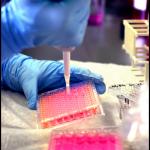
In vitro bioassays are promising tools for the assessment of drinking water quality. The technique is based on living cells that show a response once exposed to toxicants. Bioassays are already used in pharmaceutical screening, food safety assessment and chemical regulation but have not entered water regulation yet. Researchers of DEMEAU evaluated the (international) regulatory acceptance of mammalian or bacterial cell-based bioassays for human health assessment. They conclude that the derivation of trigger values, the threshold level for the bioassay to react, is the next step for acceptance by regulators.
In vitro bioassays and drinking water guidelines
So far, in vitro bioassays for drinking water quality monitoring are mainly used as a diagnostic research tools for:
- hazard identification and
- testing of treatment efficiency of novel drinking water treatment methodologies.
A wide range of in vitro bioassays has been applied for water quality assessment and play an important role in the assessment of chemical mixtures. However, to date, regulations and water quality guidelines focus on individual chemicals.
In vitro bioassays for human health hazards in regulatory frameworks
Nevertheless, in vitro bioassays for human health hazard have been accepted in other regulatory frameworks, as food safety and chemical regulation. Examples from these international regulatory policies can act as successful examples for the roadmap to implementation for the acceptance of in vitro bioassays in drinking water quality regulation.
Validation
A crucial step on the road to implementation of in vitro bioassays is their validation to demonstrate the reliability and reproducibility of a test method. However, demonstrating the validity of a method is a complicated process. All steps in the formal validation study have their challenges in terms of time, costs, and motivation. Formal validation is performed by institutes concerning the Validation of Alternatives Methods (VAM). Harmonisation of a test method (such as achieving ISO-standards and OECD guidelines) is another dominant prerequisite for regulatory acceptance and facilitates a widespread use.
Regulatory requirements
In general, three factors play an important role in the acceptance of in vitro bioassays for human health evaluation: the necessity, the usefulness and the performance. First, the necessity could be determined by the regulatory requirements, such as the prohibited use of in vivo assays (or animal tests) in risk assessment of cosmetics. Second, the usefulness implies the benefits of in vitro bioassay. Third, the performance is determined by validation requirements such as the reliability and the reproducibility. Ideally, the assay results should reflect the potency of the chemical and there should be a dose-response relation between the concentration of the chemical and the effect measured in the assay.
Implementation
Testing with in vitro bioassays has advantages over analytical techniques, such as the relatively low costs, the possibility of high-throughput methods, the derivation of mixture effects, and the preference over in vivo tests due to ethical reasons. However, several factors that hinder the implementation of in vitro bioassays in regulatory frameworks are:
- The costly and time-consuming formal validation procedures;
- Uncertainties to what extent bioassays predict in vivo responses due to organismal complexity;
- The proven relevance to apply in vivo bioassays for drinking water.
Further steps
Besides validation procedures, a further step to improve the regulatory acceptance is the derivation of human health based guideline values. This threshold can act as a filter mechanism where detailed evaluation is only performed in samples exceeding that trigger value. The trigger values can be derived in several ways.
Conclusion
Regulatory requirements in food safety and chemical regulation provide insight into the roadmap to implementation of in vitro bioassays in drinking water quality regulation. The examples have shown that three factors play an important role in the acceptance of in vitro bioassays for human health evaluation: the necessity, the usefulness and the performance. So far, no drinking water guidelines have been established for the use of in vitro bioassay results. In vitro bioassays can act complementary to analytical techniques, where only the samples with a response above the threshold level have to be examined further. The derivation of a threshold level (trigger values, bioassay guideline values) is thus an important step towards acceptance.
